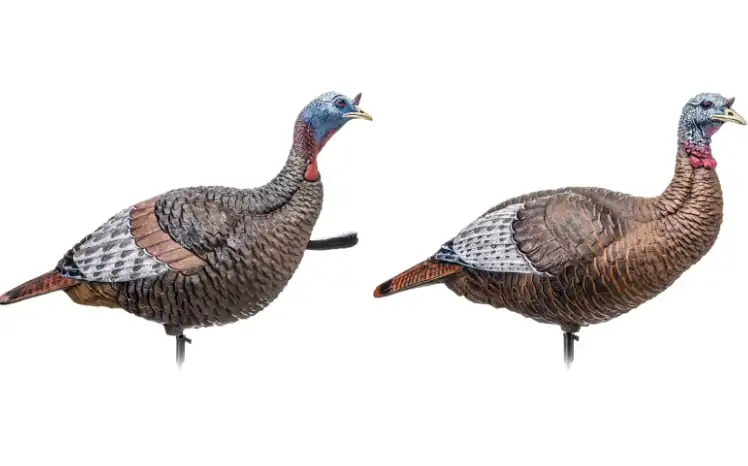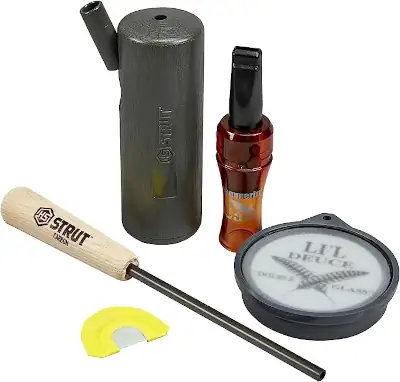Spring Turkey Hunting
In this guide on how to hunt turkeys in the spring, we’ll take you through everything you need to know to successfully harvest a turkey. Spring is the perfect time to get started, and with the right tools and techniques, you can improve your chances of success.
We will cover everything from finding the right hunting spot, to cleaning and cooking your harvest. Our goal is to provide the most complete guide on how to hunt turkeys in the spring for beginners. If you have any questions at the end of this guide, please send us a message!
Jump to a Topic:
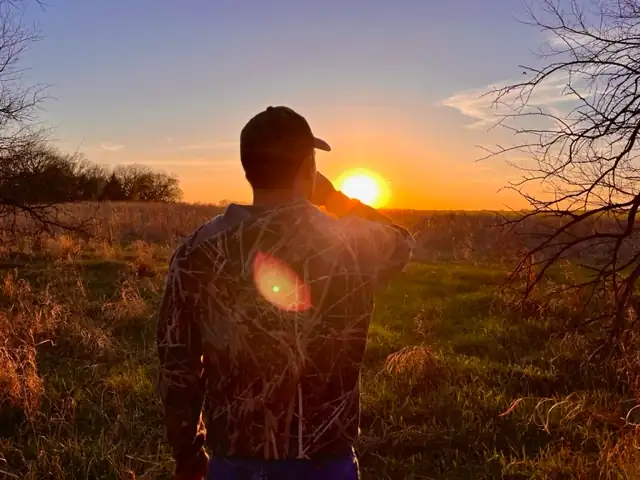
How to Scout for Turkeys
Scouting for turkeys is an essential part of any successful hunt. In this section, let’s talk tips and tricks for scouting and finding the right location for your turkey hunt. These turkey scouting strategies for beginners will help you scout with a purpose.
Where to Turkey Hunt?
5 Tips For Finding Turkey Hunting LandThe first step to scouting for turkeys is to find places to turkey hunt. For a lot of beginners, this is easier said than done. Here are 5 practical tips for how to find turkey hunting land.#1 Locate Available Public LandPublic land turkey hunting can be challenging, but for many beginners, it is the easiest way to get started. Start by searching for “Public Land Access in [State]”. Look for the government pages. States will have a map of the various land that is open for public hunting.#2 Contact your Department of Natural Resources or Fish and Wildlife Agency DirectlyIn this day and age, picking up the phone seems a bit old school. This is why simply calling your Wildlife Agency or Area Manager can be so effective. I have never talked to one that wasn’t happy to share information with me. #3 See Previous SlideSeriously. I know you don’t want to. But that is one of the most effective ways to find public land for turkey hunting.#4 Watch for Turkeys While DrivingKeep an eye out on your morning commute. It is possible you already see private land with turkeys regularly. Don’t be afraid to knock on doors and ask for permission. #5 Search OnlineYou probably won’t uncover any hidden gems, but there is a lot of information available on forums and Facebook groups. Posting a question asking for hunting spots might get you mixed results. Instead, I suggest you spend time reading through the existing posts and you will likely find other people referencing general areas.
Previous slide
Next slide
Once you have located a general area, get on google maps to see a big-picture overview of the area. Look for wooded areas, fields, and water sources. Creeks and rivers next to agriculture fields often provide good turkey hunting habitat. Put extra focus on any area that might be difficult to access or view from the road.
When to Scout for Turkeys?
3 Tips to Best Time Your Scouting TripOnce you have picked a few spots where you can turkey hunt, it is time to plan a scouting trip. When do turkeys start gobbling? Here are 3 tips for the best time to scout turkeys efficiently.#1 Early SeasonWhen people start being more active in the woods, it doesn’t take turkeys long to adapt and get very quiet. That is why one of the best times to scout for turkeys is early in the season. Ideally, you will be able to scout before the season. You will have a much better chance of hearing and locating turkeys early in the spring.#2 MorningEarly morning (about 30 min. before sunrise) is one of my favorite times to scout for turkeys. They often gobble on the roost and if you can position yourself within a half mile or so on a calm morning, you will have a good chance at hearing some turkeys and locking in a potential area for a hunt. #3 EveningRight at sunset is another time when you are likely to hear turkeys gobble from the roost. You might not have enough daylight to cover the ground to find their exact roosting spot, but you can bet the turkeys you hear gobbling at sundown will be in the same spot the next day.
Previous slide
Next slide
How to Scout for Turkeys?
A lot of online advice tells you how to look for turkey sign. We are talking about feathers, turkey droppings, scratching in the dirt, tracks, etc.
These signs might be the size of a dinner plate, across many square miles of ground. Talk about a needle in a haystack.

For experienced hunters, these signs can give clues into a turkey’s routine. However, this guide is on how to hunt turkeys in the spring for beginners.
If you are trying to shoot your first turkey, I suggest you don’t spend a lot of time looking for sign. Your goal is to locate the general area of an actual turkey. And the best way to do that is to listen for that tom to gobble.
My Favorite Way to Scout for Spring TurkeysMy favorite and most successful way of pre-season turkey scouting is to go fishing with my kayak. Spring is a great time of year to fish in the creeks and rivers of local reservoirs. In my area, white bass will start spawning in the rivers in late March. I go out early in the morning so that I am on the creek before sunrise, and as I am relaxing and enjoying my time fishing, I listen for the turkeys to gobble.Once I hear a gobble, I can easily cover ground in my kayak to get within a few hundred yards of the turkey’s roost site. I will mark that spot on my phone as a huntable area. I usually try to go back during the afternoon when the turkeys will be off feeding in a feed. I use that opportunity to get a closer look at the area and plan my hunting setup. If you can’t go fishing, the main concept for how to scout stays the same. Get out early in the morning, or right at sundown. Walk or paddle a decent distance (a quarter mile or so is a good start) away from the access point and find a good vantage point to sit and listen.
Previous slide
Next slide
Lots of hunters scout from the road or move through an area too quickly. I strongly recommend that you spend at least 30 minutes sitting silently and listening.
Oftentimes you might hear the faintest of gobbles from way off in the distance. Something you would never hear if you were rustling through the leaves on a hiking path.

How to Hunt Turkeys in the Spring: Tactics and Techniques
It might take you a few weekend scouting trips, but at this point, hopefully you have been able to roughly locate some turkeys. It is time to put a plan in place for how to hunt turkeys in the spring.
There are hundreds of different strategies and techniques for turkey hunting but I am going to cover 4 tried and proven methods for turkey hunting that will help you get started as a beginner.
How to Hunt Turkeys in the Morning: The Roost Hunt
If you have done your scouting and located birds, hunting turkeys in the morning is a natural progression. Turkeys often don’t leave the roost until after sunrise, but you want to be set up and waiting well before that. I usually try to be ready to shoot about 45 minutes before sunrise.
I will use a headlamp to get to the main field, but if I need to cross an open field to close the gap, or whenever I start to close in on the target hunting location, I like to turn the light off. The goal is to get in as close as possible without spooking the roosted turkeys.
It is important to remember that while you might know the exact tree a single tom is roosted in, there is a good chance there are other turkeys in the surrounding trees. It is always best to set up an extra 100 yards away further than you think you should be. This is a critical part of the hunt. Especially on public land with weary birds, you don’t want them to know you are there.
As daylight starts to break, you should start to hear turkeys calling from the trees. Resist the urge to call right away. I wait until they are making a lot of noise from the trees and just about to fly down before I let out a few soft calls on my slate call.
Once you hear or see one turkey fly down out of the trees, you can know that the rest will follow within the next 5-10 minutes. Let out another soft call and then be patient and read how the birds react. With any luck, they will be headed your way.
How to Hunt Turkeys Mid-Day: Run and Gun
Even if your morning hunt wasn’t successful, mid-morning can give you another chance. It is important to understand turkey behavior during this time to give you the best chance at finding birds. Turkeys are moving towards open fields to feed and loaf. If you are in a good area and can hear birds, it is worthwhile to keep the same setup until late morning.
Later in the season, hens will leave the toms to nest. That leaves the toms all alone, looking for hens. Earlier in the season though, they are likely to stay in groups longer. For early spring turkey hunting, if I don’t hear or see turkeys near my morning roost spot, I go back into locating mode.
Maybe you heard turkeys a mile off or more in the early morning. Start closing that gap and making your way toward them. As you are headed in that direction, stop every so often and see if you can locate a bird. You can use loud calls like a box call, or a locator call like an owl hoot, to try and get a tom to react with a gobble.
In the best-case scenario, you hear a tom gobble and close the gap to a reasonable distance. Then, set up and try to call him to you. Don’t overcall, every 20 minutes is plenty. When you can tell he is headed in your direction, your best bet is to stay silent except for some soft yelps if he seems to lose interest.
If you can find some turkeys but they are still grouped up, shift your focus to finding where they are headed, and try to beat them to that spot. It can be next to impossible to call a tom away from his group of real hens.
How to Hunt Turkeys in the Afternoon: Calling Them In
Early afternoons are not exactly the most exciting times to be turkey hunting in the early spring. If turkeys are still grouped up, you can expect a tough hunt. I will often pack it in and head home for a late lunch and a nap. However, if it is a few weeks into the season, the afternoon is a time to set up in a good area and wait it out.
Find a secluded part of a wheat field. A place where there are some trees, or maybe an area where the rolling hill blocks off most of the field from view. You are looking for field edges. You can also look for a meadow or a short pasture next to a creek. Set up your decoys and be prepared to wait.
For afternoon hunts, I might only set out 1 hen decoy. Having a ground blind or some way to conceal yourself is helpful for those long afternoons. I suggest calling every 20 minutes or so. If a gobbler responds, don’t get over-excited. There is a good chance he is headed in your direction. Be prepared because they can show up quickly and quietly.
How to Hunt Turkeys in the Evening: Catch Them Before the Roost
As the daylight starts to fade, turkeys are headed back to roost. Hunting turkeys in the evening is a great time to pack light. I don’t like using decoys or anything that might deter the turkeys from taking their natural path back to the roost.
Your goal is to find the field where turkeys have been feeding and loafing for the afternoon. Position yourself on the turkeys exit of that field on the way to the roost. Get set up well in advance. Turkeys will be very weary and will likely easily spot you along the field edge if you are trying to slip in once they are already in the field.
If you are in place and then find that the turkeys are taking a different route, you will likely have better luck trying to change your ambush point than calling them off their route. But, if the turkeys are making their way out of the field and you find that they are going to walk past just out of range, don’t be afraid to let out some soft calls. That can be enough to pique their curiosity enough to get into shotgun range.
One quick tip for how to hunt turkeys in the evening. Don’t sit too close to the roost tree. Keep in mind that turkeys may need to fly for 30 yards or more, possibly up to 100 yards, before they get to the roost tree.

Essential Turkey Hunting Gear
There is a lot of turkey hunting gear available and it can be tough to sort through what the essentials are. I am going to list out gear in order of most important to least important so you know what you need for turkey hunting.
Turkey Hunting Shotguns
In most states, both shotguns and archery are legal equipment for hunting turkeys. For the sake of this beginners turkey hunting guide, we will stick to shotguns.
What Shotgun to Use for Turkey hunting?
Turkey hunting doesn’t require a fancy shotgun. A 12 gauge used to be the most popular but with special tungsten shotshell options, 20 and .410 gauge are very viable shotguns for turkey hunting (check your state laws to see if .410 is legal).
What Choke to Use for Turkey Hunting?
Most turkey hunters use a full or extra-full turkey choke for hunting turkeys. These will give you tighter shot patterns, giving you more pellets on target at distances up to 30-40 yards.
What Ammo to Use for Turkey Hunting?
If you don’t mind paying a little extra, special tungsten turkey loads will give you the most distance. Tungsten is 1.7 times denser than lead, giving you more knock-down power over longer distances. For a beginner, I think the premium ammo is worth it, and it will improve your chances of harvesting a turkey.
If price is a concern, regular lead (or steel if non-toxic is required in your hunting area), has worked just fine for decades. Shot size 4-6 is typically recommended in steel/lead, and 7-9 for tungsten.
Mossberg 500 Turkey Pump-Action Shotgun
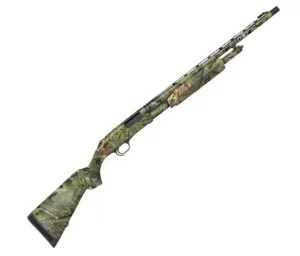

Carlson’s TSS Turkey Choke Tube
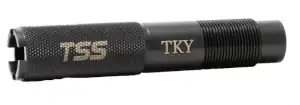

Federal Premium TSS Turkey Shotshells


What to Wear for Turkey Hunting
Turkeys have excellent vision and sitting still with good camouflage is essential. Spring turkey hunting can bring cold mornings and hot and humid afternoons, so dressing in layers is a smart choice. The great thing is, you don’t have to go out and buy specialized gear. Make use of what you already own to get started, and upgrade components as you gain experience and want better comfort.
Turkey Hunting Boots
Consider a more traditional boot if you plan on long hikes, but I like a good pair of rubber boots with medium insulation for turkey hunting. They allow me to cross wet fields and shallow creeks without worrying about getting my feet wet.
I often use these RedHead boots for spring turkey hunting. They only last a few seasons before they get small cracks and are no longer waterproof, but for the price they are tough to beat.
RedHead Camo Utility Rubber Boots


Turkey Hunting Pants
I prefer a pair of lightweight coveralls or bibs for turkey hunting pants. The pockets are great for carrying extra gear. Waterproof isn’t a requirement but it sure is nice on mornings with lots of dew on the ground.
These aren’t waterproof, but they don’t have insulation either, making them a great choice for later in the season.
RedHead Silent-Hide Uninsulated Bibs


Turkey Hunting Jacket
Again, as a beginner, you don’t need specialized turkey hunting clothes here. Early season I will often wear a camouflage hoodie and transition to a long sleeve camo t-shirt if it warms up in the afternoon.
RedHead Quarter-Zip Hoodie


Turkey Hunting Facemask
If you don’t have a turkey hunting facemask, that is one piece of gear I would highly recommend you purchase. Sitting on a field edge, your face will likely be the most visible part of your body. If you don’t cover that up, you will likely stick out and spook turkeys.
A lightweight mesh is great for late season hunts but something like this 3/4 spandex will be good for early to mid-season.
RedHead Form Fit Spandex Face Mask
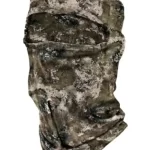

Turkey Hunting Gloves
Another highly recommended piece of camo would be a pair of lightweight camo gloves. It is critical to make as little movement as possible when a turkey is in close, but your hands are likely to be making the most movement as you swing your shotgun into position.
Most of my beginner recommendations for turkey gear are the middle of the road option. Cheaper, but will work for a lot of scenarios. After wearing out 3 pairs of gloves, they are one piece of gear I think it is worth spending extra money on for higher quality.
Sitka Subalpine Series Traverse Gloves


What Call to Use for Turkey Hunting
After you have your shotgun and camo covered, calls will be the next turkey hunting gear you should consider. For beginners, I recommend a box call for loud volume on windy days, and a pot or friction call for the soft, early morning calling.
See the full post on the 6 best turkey hunting calls.
Turkey Hunting Box Call
Box calls are a popular and versatile option for turkey hunting beginners. They are easy to use and can produce a range of turkey sounds, from soft purrs to loud yelps.
Lynch’s Fool Proof Box Turkey Call
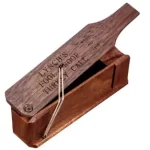

Turkey Hunting Pot Call
The two most common materials for pot call surfaces are slate and glass, with each having its own unique sound characteristics. Slate produces a softer, more subtle call, and glass creates a higher-pitched call.
I own both types but my favorite for early morning is glass. It can get very quiet while the higher pitch travels better, allowing the turkeys to hear it without getting aggressive on the call.
HS Strut Combo Kit
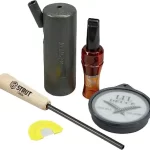

Turkey Hunting Essential Accessories
If I go on a spring turkey hunt, I am taking all the gear above, every time. The gear next on the list are things that I will occasionally hunt without. As a beginner, they aren’t exactly required, especially if you are trying to stick to a budget. However, these turkey hunting essential accessories can help you have a more successful hunt if you use them correctly.
Turkey Hunting Decoys
A versatile option for turkey decoys is a jake decoy and a hen. I will often set them both up in the morning, and switch to just the hen in the afternoon. Later in the season, decoys can be less effective as mature gobblers will hang up outside of range. But for hunting turkeys in the spring, having a pair is usually a safe bet.
Flextone Jake and Hen Turkey Decoy Combo
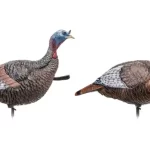

Turkey Hunting Chair
One of my favorite pieces of turkey hunting gear is a low-profile chair. On long hikes where I don’t want to take a blind, having a comfortable chair makes a huge difference in my ability to sit still for long periods. For a beginner turkey hunter, a low-profile chair might not look very comfortable. But trust me, it is a great option for long sits, and being low to the ground helps you stay hidden.
Cabela’s Hunting Lounger Turkey Chair
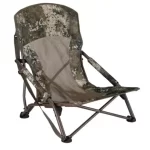

Turkey Hunting Blind
A turkey hunting blind isn’t a great option for run and gun style hunting, but if you are planning on long afternoon sits, it can be a great piece of turkey hunting gear. A blind can provide cover and concealment from the keen eyesight of a turkey, allowing you to get away with more movement while setting up for a shot.
Ameristep Brickhouse Ground Blind
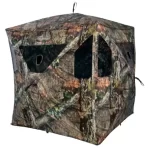

Turkey Hunting Extra Gear
If you are a spring turkey hunter beginner, I would focus on the gear listed above. But if you have all those items covered, it is worth considering adding a few extras to your gear list.
Headlamps are a helpful tool for walking to your spot in the dark. Just try to shut them off as you get closer to the roost.
A pair of pruning shears always comes in handy during the setup process. I use them to clear small branches that are in the shooting lane, allowing me to tuck back further into the trees for better camouflage.
Binoculars are great if you are field hunting for turkeys. Being able to get a better view helps you read the turkeys behavior and decide how to react. Magnification is an entire subject on its own but I like 10×42 for turkeys.
Rechargeable Head Lamp
8″ Pruning Shears
Vortex Diamondback Binoculars
How to set up Turkey Decoys?
Decoys can be a valuable tool but it’s important to know how to use turkey decoys effectively. Turkey hunting in the spring is one of the best times to utilize a jake and hen decoy combo. Early season, toms have seen less pressure, so they are typically less weary of decoys. They are also establishing their territory and looking for opportunities to breed, so they are more likely to challenge a less dominant bird.
A typical turkey hunting decoy setup involves a jake and hen decoy set a few feet apart, about 20 yards away from the hunter. Once a dominant tom spots the jake decoy, he can become aggressive and try to assert his dominance by attacking the decoy. This can lead to some exciting turkey hunting as the toms can come in quickly, gobbling all the way.
It is important to use caution when using decoys, especially in public hunting areas or areas with high hunting pressure. You don’t want another hunter sneaking up on your decoy mistaking it for a live turkey.
How to Call Turkeys in the Spring?
Turkey Hunting Calls for Beginners
The most common types of turkey calls are box calls, friction calls, diaphragm calls, and locator calls. See the 6 Best Turkey Hunting Calls. Box calls are great for producing loud and sharp sounds that can reach far distances.
Friction calls produce softer sounds that mimic the purring and clucking of turkeys. Diaphragm calls are placed inside the mouth and produce various sounds when air is blown over the reeds.
Locator calls, such as owl hoots or crow calls, can be used to locate turkeys and get them to gobble. Although, I find that you need to be fairly close to a turkey to begin with for the call to be loud enough to get the turkey to gobble.
I recommend a box call and a friction call for turkey hunting beginners. These calls are relatively easy to learn the basics and they will cover a wide range of scenarios.
The HS Strut Combo listed above has my favorite friction call, along with some of the other types to experiment with. It is a great turkey hunting call option for beginners.
What Time Should You Start Turkey Calling?
Turkeys will stay in the roost for a fair amount of time. I find that they fly down around sunrise as a general rule. It will be plenty light enough to see well. Depending on how much noise the turkeys make, I will start making a few soft calls 5-10 min before sunrise, making sure to leave 5-10 min in between calls.
If you are set up by the roost spot in the morning, timing your turkey calling is very important. You will want to make soft, subtle calls. This is not the time for loud box calls. I like to use a glass friction call to make high pitch, soft-sounding purrs and clucks.
Hunting Story and AnalysisMy #1 turkey calling tip when hunting the morning roost.Morning Calling TipAs soon I hear or see a single turkey start to fly out of the tree, I make a little louder yelp on my call. Even if I am not in the exact landing spot, that yelp is often enough to trick the rest of the still roosted turkeys into thinking my location is where the first turkey landed.Hunting StoryI once slipped into a small clearing on public land on a wet and rainy morning. The wet ground played to my advantage and I was able to slip in to about 50 yards from some roosted turkeys in the pitch black without making much noise. The big tom was the first to leave the tree, flying across to the other side of the creek.Calling at the Right TimeI thought my hunt was ruined, but I quickly gave a soft yelp. 1-2 minutes passed by, and the two hens left the tree and landed within about 20 yards from my spot where I was leaning back against a nearby tree. I didn’t dare move an inch. After waiting about 20 minutes, the tom snuck in from the side to join the hens, and I was able to harvest a nice, mature, public land tom.Read the Birds and ReactIn that hunting scenario, calling before the tom left the tree is likely what pushed him to go to the other side. I had been chasing that bird most of the season and he was very weary, steering clear of all my decoys and tactics. In fact, on this hunt, I took nothing but my gun and some shells as I was trying to be as stealthy as possible. But, a quick call at the right time to the hens in the tree saved the day, and I went home with a bird.
Previous slide
Next slide
How Often Should You Turkey Call?
For a beginner turkey hunter, calling every 20 minutes is a good rule of thumb. Hunters often make the mistake of overcalling, which can spook birds. You need to be able to learn how to read the turkeys response and adjust accordingly. This will come with practice, time spent in the field, and watching real turkeys.
If you are set up with decoys in a good location, and not getting any response, I recommend making a loud 4-6 note yelp roughly every 20 minutes. If a gobbler responds right after a call, I may wait as long as 30 minutes before calling again. However, if it sounds like the gobbler has not moved very far from the first call, I will start to increase the calling aggressiveness and frequency.
What Sounds do Turkeys Make in the Spring?
Turkeys make a wide variety of sounds in the spring. The most common are gobble, yelp, cluck, purr, and putt. You will likely hear other turkey sounds and variations of these calls, but these are the most important for being able to talk turkey.
The turkey gobble is an unmistakable sound and is easily recognized by even people that don’t turkey hunt. As a hunter, this sound is exciting to hear as it means turkeys are near, but you won’t find yourself making this very often.
It can be used as a locating call, as other dominant toms will often respond with their own gobble when they hear another turkey gobble. It can also draw in aggressive toms who think another turkey is in their area. But in general, I find this to be a fairly low-use call while hunting.
The turkey yelp is an important call for spring turkey hunters. It is a series of single-note sounds that are often described as “kee-kee-kee” or “yelp-yelp-yelp” and can vary in pitch and speed.
Yelps are used for various purposes such as communication and locating other turkeys. When I make a turkey call on the 20-minute interval, the yelp is the default call. You can make this call with various intensity and volume depending on how the turkeys are responding.
A turkey cluck is a short, sharp, single-note vocalization made by both hens and toms. It is a soft and subtle sound, often used to communicate with other turkeys at close range.
A turkey purr is a soft, rolling call used to indicate to other birds that they are content and relaxed.
Between the yelp, cluck, and purr, you will be able to make 95% of the sounds needed for any type of turkey hunting.
This is a sound you don’t want to hear while you are turkey hunting. It can be a single, or several sharp notes. Turkeys use this to signal danger and alert other birds. It is often accompanied by the turkey freezing in place and raising its head and neck to locate predators.
If you hear this sound, know that the turkey will take off at the slightest movement. If you have a chance at a shot, you better take it quickly because you don’t have much time before the turkeys leave.
This is also an important call to understand as a turkey cluck can sound similar, so you don’t want to accidentally make a putt when you are trying to lure in a weary tom. The putt is louder, sharper, and can be described as a single note ‘pit’ sound.
Where to Aim When Turkey Hunting?
So far in this guide, you have scouted and located turkeys, got the right gear, set up your decoys, and called a nice tom into range. Now it is time to make the shot.
Shot Placement for Turkey Hunting with a Shotgun
For a beginner, shot placement for turkey hunting is pretty simple, but it’s important to understand before heading into the field.
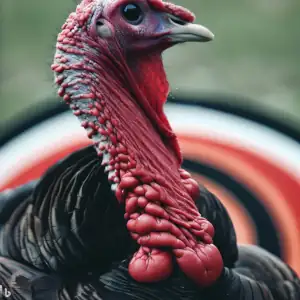
The most effective shot placement is aiming for the turkey’s head and neck area. The head may be small, but it is the most vulnerable area. An on-target shot will result in a quick and clean kill.
Don’t be tempted to shoot at the body. It is a large target, but the vitals are small and protected by lots of dense feathers, meat, and bone.
Aim for the Neck
The head and neck area is the general target area. If you want to know where to specifically aim when turkey hunting, the answer is at the neck. Ever see a chicken peck at the ground? Their head moves pretty quick. Turkeys do the same, along with gobbling. By aiming at the base of the neck, you make sure your pattern is perfectly centered in the optimal range, even if the turkey happens to make a quick movement.
How to Clean and Cook a Turkey
Turkey hunting can be a challenge, but you now have all the basic tools and information needed to get out in the field and start chasing turkeys. Next, we need to cover what happens after the hunt.
How to Clean a Wild Turkey in 5 Steps
There are several methods to clean a wild turkey. They have anatomy similar to a chicken, so you can remove the breast meat, legs, and thighs separately, or you can leave the bird whole. For a beginner turkey hunter, I recommend separating each cut of meat. It is the easiest way to clean the bird and will give you nice cuts of meat to cook with.
You can lay the bird on the tailgate of your truck or other similar cleaning table surface. Flip the bird on its back with the head pointing away from you and the feet towards you. Use your finger to find the breastbone that runs down the middle of the turkey. At the base of this bone, make a small incision.
Use your fingers to pull back the skin away from the meat to expose it. Continue pulling the skin back until you can see the turkey legs and the wings.
Run your finger down the length of the breastbone. Insert your knife to one side, and slowly fillet the meat off as cut straight down. After cutting an inch or so straight down into the meat, you will feel the ribcage. Gently pull the meat back so you can see and fillet the meat as you work your knife close to the bone.
Go back and pull the skin off the rest of the legs and thighs, all the way to where the feathers connect to the rest of the foot. Push the thigh down and away from the bird to expose the socket. Use your knife to cut the joint and then finish cutting the thigh away from the turkey, leaving as much meat on the thigh as possible.
You can then bend the lower joint until it snaps. If you are having a hard time, bend the joint and then carefully slit it with your knife to expose the socket. Then you can cut it the rest of the way with the knife.
If the meat is dirty, rinse it off with clean water before patting dry and putting it in the fridge. After your hunt, you want to get your meat cooled off as quickly as possible to avoid spoilage or any off-taste. If you travel a long way to get to your hunting spot, it can be a good idea to have a cooler with ice ready for your turkey.
Wild turkey is one of my favorite game animals to eat. It can be delicious. But proper care of the meat post-harvest is essential to avoiding that classic ‘gamey’ taste that many people complain about.
How to Cook Wild Turkey
I recommend cooking the thighs/legs and the breast meat separately. They have different cooking requirements, and it is easier to get great-tasting meals out of each if you cook them separately.

Just like any wild animal, turkey meat is lean and can easily dry out during the cooking process. That is why it is important to brine the breasts before cooking. Here are my two favorite easy wild turkey recipes.
Smoked Wild Turkey Recipe
This is a perfect recipe for the turkey breast. It goes great as the main course with any traditional Thanksgiving-style side but also makes some insanely good sandwiches the next day.
Turkey Brine
4 cups of water
¼ cup salt
¼ cup brown sugar
1 onion sliced
2 bay leaves
2 tsp each of various herbs (peppercorns, garlic, thyme are a good starting point)
Dissolve ingredients in water and cool for the turkey brine. (DO NOT skip this step if you plan to smoke a wild turkey!)
Brine the turkey for 12 hours or overnight.
Smoked Turkey
Lightly season the turkey with any poultry rub or your favorite seasoning. I wouldn’t recommend adding any seasoning mixture that has salt.
Smoke the turkey at 225°F for 3-4 hours, or until the temperature reaches 160°F.
Wild Turkey and Noodles
Slow-cooking turkey thighs is my favorite turkey leg recipe because they are tough and full of tendons. Deboning the thighs after the cooking process is a bit of work, but it is 100% worth the effort.
Wild Turkey and Noodles
1 c. yellow onion
1-2 c. diced celery
1-2 c. diced carrots
1 bay leaf
16oz cream of mushroom soup
1/2 c. chicken stock
8-16oz mushrooms (optional)
Season turkey thighs generously with salt, pepper, thyme, and oregano.
Add vegetables to a crockpot. Lay turkey thighs on top and cover with soup, chicken, and mushrooms.
Cook on low for 6-8 hours or until the meat is tender. Debone the meat and stir it back into the crockpot.
Serve over egg noodles or thicken with cornstarch and serve with mashed potatoes.
More Turkey Hunting Content
Turkey hunting in the spring can be an exciting and rewarding experience for beginners. With a good knowledge of turkey hunting tactics, enough time spent scouting, and the right gear/setup approach, you can increase your chances of harvesting a bird this spring.
I hope this guide helped you in your goal of learning how to hunt turkeys in the spring for beginners. As an avid hunter myself, I love helping others get involved in the various aspects of hunting that I find so enjoyable. Have more questions? Be sure to check out our FAQ list below or contact me directly to talk turkeys.
If you enjoy our website, make sure to sign up for our email list to get exclusive email content. You control what information you want to see, and you can unsubscribe at any time. I get tired of companies spamming my email inbox daily, so I only send out emails that I would be excited to receive.
Turkey Hunting Frequently Asked Questions
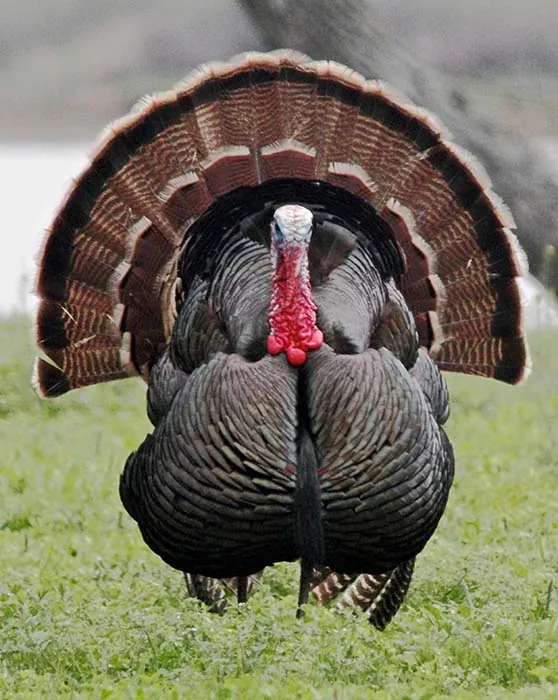
Can You Turkey Hunt in the Rain?
One of my favorite turkey hunts was done late in the season on a rainy morning. The dirt road was so muddy I couldn’t get my little 2wd truck to the parking spot, so I left it at the corner on the gravel road and hiked almost a mile just to get to the parking spot. The work paid off as I finished that rainy hunt with a tom I had been chasing most of the season. So the short answer is yes, you can turkey hunt in the rain.
Hunting in the rain can be uncomfortable if you don’t have the right rain gear. Additionally, you will find that turkeys are less likely to move around and may stick to cover. I personally don’t turkey hunt when an all-day rain is forecasted unless I have a specific plan and location in mind where I expect to see turkeys. But don’t let a morning or afternoon shower keep you out of the field. The rain can keep other hunters home, resulting in less pressure in the woods and a possibility of success for anyone who gets off the couch to try.
Why is Turkey Hunting Hard?
Turkey hunting can be challenging because they are naturally very weary birds. They have excellent vision and will quickly leave the area if they see something out of place. Especially on heavily hunted public land, turkeys seem to have a knack for avoiding hunters’ decoys and setups.
Turkey hunting tactics are varied, and they all have a place in a successful hunter’s arsenal. It takes time and experience to learn how to read turkeys and use the right tactic to give you the most opportunity for harvesting a bird.
Do Turkey Hunters Wear Orange?
Turkey hunters may be required to wear orange during fall rifle seasons if that is something a specific state allows. However, it is not required during spring shotgun seasons.
Can You Turkey Hunt in the Evening?
Make sure to check your local laws as some states do not allow turkey hunting in the evening. For the rest of us, turkey hunting in the evening can be another approach used to try to bag a turkey.
Remember that in the evenings, turkeys are likely headed to roost. They won’t be easily coaxed off course. Evenings are a good time to set up near a roost site to try to ambush turkeys along their route.
Can You Turkey Hunt in the Wind?
Yes, you can turkey hunt in the wind, but it can be more challenging to locate and call birds. Turkeys will be less vocal and can be more cautious.
On windy hunts, I plan to use a louder call like a box call and look for areas that are protected from the wind to set up.
When is Turkey Season?
The exact dates of turkey season can vary by state, but typically turkey hunting takes place in the spring and/or fall. Spring turkey season can start as early as March or April and lasts through May. Fall turkey season generally takes place in October and November. It is important to check with your Department of Natural Resources or Fish and Wildlife for specific dates and regulations in your area.



